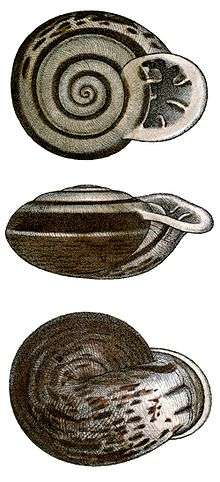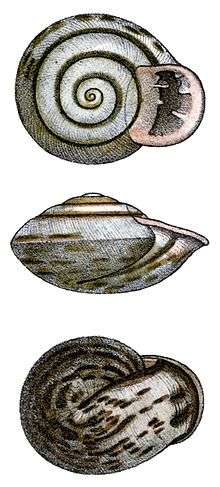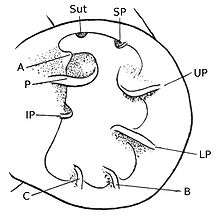Anostoma
Anostoma, common name the up-mouth snails, is a genus of tropical air-breathing land snails, terrestrial pulmonate gastropod mollusks in the family Odontostomidae.[2] Snails in this genus are found in Brazil.
| Anostoma | |
|---|---|
 | |
| A colored drawing of an adult shell of Anostoma octodentatum | |
| Scientific classification | |
| Kingdom: | Animalia |
| Phylum: | Mollusca |
| Class: | Gastropoda |
| Subclass: | Heterobranchia |
| Superorder: | Eupulmonata |
| Order: | Stylommatophora |
| Informal group: | Sigmurethra |
| Superfamily: | Orthalicoidea |
| Family: | Odontostomidae |
| Genus: | Anostoma Fischer von Waldheim, 1807[1] |
| Synonyms | |
|
Also note that this genus name has frequently been misspelled as "Anastoma"
| |
Adult snails in this genus have an extremely unusual shell morphology: the aperture of the adult shell faces directly "upwards", in other words, in the same direction as the spire.[3] This seemingly impossible arrangement is made possible because the adult shell is carried upside down.
In 1901, the American malacologist Henry Augustus Pilsbry[3] commented that the adult shell of Anostoma is "so bizarre that in the total absence of information upon its life history, no useful theory can be formulated to account for its peculiarities."
A very similar shell is found in the genus Ringicella Gray, 1847, which was previously considered to be merely a subgenus within Anostoma, but it is now considered to be a genus in its own right.
How the shell is carried


This is one of the most peculiar genera of land snails. The prominent feature of an upturned aperture (causing the adult snail to carry the shell spire down) is reflected in its scientific name Anostoma: ano, means up, or backwards, and stoma means mouth, from the Greek.[3]
In this genus, the adult snails carry the shell completely upside down, with the umbilicus uppermost, and the spire facing downwards. To make this extraordinary feat possible, the mature aperture of the shell is aligned in the same plane as the rather low spire of the shell.
It appears that in juveniles, the shell is carried with the widest diameter vertically aligned, in other words, with the keel of the shell pointing up.[4]
Shell description
The width of adult shells varies from 23 to 45 mm.[3]
Thomas Wyatt (1838)[5] wrote about Anostoma: "An extraordinary shell, sometimes called the antique lamp from its form. Shell orbicular, the spire convex and obtuse; aperture round, toothed within, grinning, turned upward to the spire; margin reflected."
The shell of Anostoma is heliciform, biconvex, solid, the axis hollow, but imperforate in the adult stage. The shell is composed of few whorls, the last straightened, turning toward the margin and upward.
Before the last half whorl is formed, the shell is umbilicate, and judging by the growth-lines, the juvenile and subadult shell is carried with the equatorial plane nearly vertical. However, as the last half whorl starts to form, the direction of growth changes: it tilts to the right, not to the left as in the Helicidae, and subsequently that half whorl grows up across the base of the shell.[3] The final aperture in the adult is slightly above the keel or widest diameter of the shell.

Sut = sutural fold
SP = suprapalatal fold
UP = upper palatal fold
LP = lower platal fold
B = basal fold
C = columellar lamella
IP = infraparietal lamella
P = parietal lamella
A = angular lamella
The apex of the shell is smooth and somewhat flattened.[3] The peristome is expanded and reflexed.[3] The semicircular aperture is turned upward, obstructed by numerous lamellae and folds.[3] In the aperture of Anostoma, the primitive condition of the parietal armature remains, the angular, parietal and infraparietal lamellae being all present and separate.[3] In Anostoma the parietal lamella is the longest while in other Odontostomini the infraparietal lamella is the longest.[3] The "teeth" of the aperture are entirely homologous with those of Odontostomus.[3]
The similar genus Ringicella has an additional feature on its shell: the angular lamella and upper suprapalatal fold are concrescent and form a perforation in the lip at its upper end.
Anatomy
Pilsbry described the anatomy of what is now known as Ringicella ringens.[3] At the time that species was described as an Anostoma, and Pilsbry (who was very thorough) did not make any comments that implied that there was any difference between the anatomy of that species and that of any of the other Anostoma species he examined. Thus, see Ringicella#Anatomy.
Anatomy of Anostoma depressum was examined by Harold Heath in 1914.[4]
Distribution
This genus of snails occurs in Brazil.
Species

Species within this genus include:[6]
- Anostoma baileyi Solem, 1956[7]
- Anostoma brunneum Verdcourt, 1991
- Anostoma carinatum Pfeiffer, 1853
- Anostoma depressum (Lamarck, 1822)[8]
- Anostoma deshayesianum Fischer, 1857[9]
- Anostoma octodentatum Fischer von Waldheim, 1807[1] - Brazilian up-mouth snail. This is the type species for the genus. The type locality is tropical South America, east of the Andes.
- Anostoma octodentatum verreauxianum Hupé, 1857 (photo)
- Anostoma rossi Weber, 1925[10]
- Anostoma tessa Simone, 2012[11]
- Anostoma verreauxianum Hupé, 1856
Synonyms
Very similar to the genus Anostoma, the taxon Ringicella is currently considered to be a genus in its own right. Species that are now in the genus Ringicella were previously included in the genus Anostoma.
Synonyms:
- Anostoma carinatum Pfeiffer, 1853 is now a synonym for Ringicella carinatum (Pfeiffer, 1853)
- Anostoma luetzelburgi (Weber, 1925) is now a synonym for Ringicella luetzelburgi (Weber, 1925)
- Anostoma ringens (Linnaeus, 1758), Anostoma globulosa Lamarck, 1822 and Anostoma globulosum Lamarck, 1822 are all synonyms for Ringicella ringens (Linnaeus, 1758).
References
This article incorporates public domain text from reference.[3]
- Fischer von Waldheim, G. 1807. Vegetaux et Animaux 3: IX+330, 6 pls. In Conchyliologie. Muséum Demidoff, ou catalogue systématique et raisonné des curiosités de la nature et de l’art données à Université Impériale de Moscou par S. E. M. Paul de Demidoff.
- Breure A. S. H. & Ablett J. D. (2012) "Annotated type catalogue of the Bothriembryontidae and Odontostomidae (Mollusca, Gastropoda, Orthalicoidea) in the Natural History Museum, London". ZooKeys 182: 1-70. doi:10.3897/zookeys.182.2720.
- Pilsbry H. A. 1901. in Tryon G. W. & Pilsbry H. A. 1901-1902 - Oriental Bulimoid Helicidae. Odontostominae. Cerionidae Volume 14. Manual of Conchology. Second series: Pulmonata. page 25–28 and 109–114.
- Heath H. 1914. The anatomy of two Brazilian land-shells, Anostoma depressum and Tomigerus clausus. Proceedings of the Academy of Natural Sciences of Philadelphia, 65: 688-692, plate 31 [1913].
- Thomas Wyatt. 1838. A Manual of Conchology: According to the System Laid Down by Lamarck, with the Late Improvements by De Blainville Exemplified and Arranged for the Use of Students. Harper & brothers, page 109.
- Norma Campos Salgado & Arnaldo C. dos Santos Coelho. 2003. Moluscos terrestres do Brasil (Gastrópodes operculados ou não, exclusive Veronicellidae, Milacidae e Limacidae) Archived 2011-10-04 at the Wayback Machine. Rev. Biol. Trop. 51 (Suppl. 3): 149-189. (in Portuguese with English abstract)
- Solem A. 1956. Non marine Mollusca from Salobra, Mato Grosso, Brazil and a collection of South Brazilian Artemon. Notulae Naturae, Philadelphia, 287: 1-14.
- Lamarck J.B.P.A. 1819-1822. Mollusques In Histoire Naturelle des Animaux sans vertebres. Paris. 6 (1): 1-343 (1819), (2): 1-232 (1822). page 101.
- Fischer P. & H. Hupé. 1857. Description de deux espèces nouvelles du genre Anostoma Fischer. Journal de Conchyliologie, Paris, 5: 330-354, pl. 12, figs. 1-2.
- Weber, A. 1925. Konchyliologische Erebnisse liner Forschungsreise Dr. V. Lützelburg’s in Brasilien, Zoologische Jahrbucher Abeitelung für Systematik, Ökologie Geographie und Biologie der Tiere, Jena, 50 (3): 273-282, pl. 5.
- Simone, L. R. L. (2012). "Taxonomical study on a sample of pulmonates from Santa Maria da Vitória, Bahia, Brazil, with description of a new genus and four new species (Mollusca: Orthalicidae and Megalobulimidae)". Papéis Avulsos de Zoologia. 52 (36): 431–439. doi:10.1590/S0031-10492012021600001.
External links
| Wikimedia Commons has media related to Anostoma. |